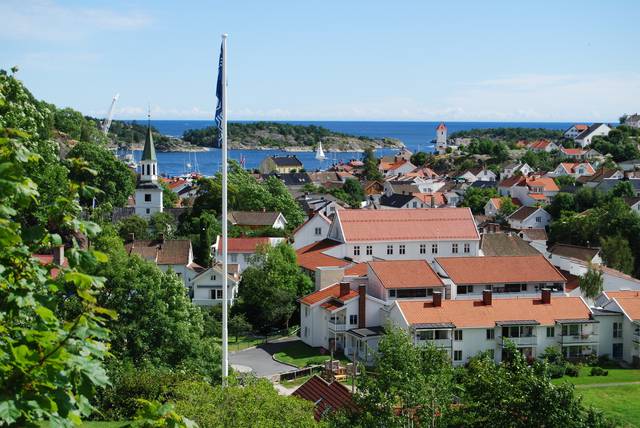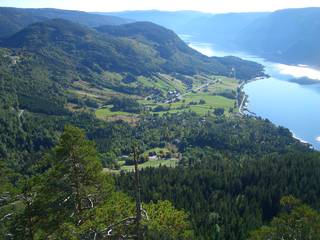
South Norway, in Norway called Agder or Sørlandet, is the southernmost region of Norway. The coast of southern Norway is often called the Norwegian Riviera. The picturesque towns and the enchanting archipelago is surrounding the Skagerrak - coast, inland is perfect for hiking and the mountains there are good opportunities for skiing in winter. All surrounded by beautiful nature scenery. The climate, particularly along the coast is mild compared to other places in the Nordic countries. Southern Norway has the highest number of recorded hours of sunshine per day in Norway.

- Arendal -- Coastal town
- Evje -- provisioning before entering Setesdal
- Farsund-- Coastal town, known for its rich architecture
- Flekkefjord-- Coastal town in southwest
- Kristiansand -- Largest city and centre of the area
- Lyngdal -- A pleasant small town by three fjords
- Lillesand -- A cozy small coastal town
- Mandal -- A small town in the souternmost part of Norway
- Risør -- Coastal town, known for white wood houses

- Setesdal - a major valley in midle of the interior from Kristiansand to the uplands at Hovden
- Hovden -- ski centre in Setesdal

The coast is lined with picturesque white-painted wood towns surrounded by lovely archipelago . The south coast is a favorite vacation area for Norwegians in the summer. It's easy to travel between the coast towns. Outside the towns, however, public transport is infrequent. The inland is less visited, but those interested in trekking to pretty solitary lakes or whitewater activities - or mosquitoes - should give it a try. Relatively lowland of the coast gradually gives way to big valleys and high plateaus and real mountains. The interior and the coast has different character and were in fact separate counties. Due to difficult transport the interior valleys, notably Setesdal, was long relatively isolated from the coast. Setesdal still takes care of its cultural heritage in terms of dialect, music, traditional clothing (for special occasions only) and silverware. Traditional costumes are easily recognized. Setesdal is some 150 km and cuts sharply into the bedrock with characteristic steep, polished cliffs rising abruptly from the relatively flat valley floor. some 40 km of the valley floor is occupied by the Byglandsfjord-Åkrafjord lakes. These are two separate lakes that appear as one. They appear as fjords and are indeed called "fjord" according to naming convention. The river often widens to what appears as lake. The coast is heated by the ocean and winters are relatively mild, while in the interior winters can be cold and heavy snowfall is common. Population is concentrated along the coast close to the water where the towns are. In the interior there are only villages. Agder is divided in two administrative areas - Vest-Agder and Aust-Agder counties, that is, West and East Agder. For the visitor this division has no significance, but road signs will indicate county line. The western part in particular has strong ties to USA because of emigration and many emigrants that returned. This is most visible in Lista, Vanse, Farsund and Kvinesdal areas. American cars, American diners, "Brooklyn Square" make this the closest one gets to USA in Norway. Many emigrants returned and brought US style houses home, some even with US voltage (120 V). Some 10 % of the inhabitants are US citizens.

Most people will respond in English to any question you may have. Some Norwegians also speak some German, due to the proximity of the language, and that they study it in school.
The south coast has characteristic dialect with for instance "d" is often used where other Norwegians use "t", while "b" is often used instead of "p". This gives the southern dialect a notable softer tone similar to Danish. Those interested in dialects, can also observe a remarkable difference in Setesdal compared to the Danish-sounding Kristiansand dialect, to the very different north valley dialect that sounds more like Gaelic. In several inland municipalities, a writing form of Norwegian usually associated with West Norway known as Nynorsk is the official form. Closer to the coast, the general rule is that people tend to speak a dialect more and more similar to East Norwegian dialects the further east you travel. East of Tvedestrand, a rolling r is applied while western areas use the voiced uvular fricative like in French and German.

The beautiful landscapes of South Norway
- Norwegian coast of Skagerrak also called "The Norwegian Riviera", known for the beautiful archipelago
- Setesdal and the inland, where you will find forests and mountains, ski resorts, lakes and rivers suitable for fishing, rafting, canoeing and kayaking.
- Kristiansand Zoo and Amusement park
- Lindesnes Lighthouse
- Setesdalsbanen heritage railway, Vennesla -8 km preserved steam powered railway that once connected Kristiansand and Setesdal via Byglandsfjord.

- E18 Risør - Tvedestrand - Arendal - Grimstad - Lillesand - Kristiansand
- E39 Kristiansand - Mandal - Lyngdal - Farsund - Flekkefjord
- Norwegian National Route 9 Kristiansand - Evje - Setesdal - Hovden
- Ferry Hirtshals, Denmark - Kristiansand

- Water based
- Land based ( Hiking, Skiing, Cycling, etc)
- Island hopping
- Steam boat trip with D/S Bjoren on the lake Byglandsfjorden
- Train ride with the Setesdalsbanen heritage railway line
- Visit Kristiansand Zoo and Amusement Park
Norwegian cuisine is known for eclectic food with a good supply of many local ingredients. Try Norwegian seafood!
Local Norwegian beer, aquavit and cider. Along the Skagerrak coast several local breweries and microbreweries are brewing beer that are definitely worth tasting, although prices are high. Or simply drink clean and fresh tap water.
Apart from those associated with outdoor activities, there are few dangers. Every year there are reports of foreign visitors that get into trouble in small boats at sea, fatal incidents also occur. The high moor-like plateaus can be difficult to navigate, particularly in bad weather. Map, compass and appropriate clothing are needed on hikes. Weather in the mountains and on the high plateaus can be very different from the coast and low-land weather. Winter driving - While the coast is relatively mild, heavy snowfall and difficult driving is common also along roads E18 and E39. Driving in the interior in winter requires skills and experience. Winter tires are recommended from November to mid April, but studded winter tires are not allowed outside the winter season. Animal collisions - Moose and row deer ("rådyr") are relatively common in the forest areas of Agder. Drivers should be cautious at dusk and dawn where road runs through pine forest.

- ☎ Police: 112
- ☎ Fire: 110
- ☎ Emergency Medical Services : 113
- If you are unsure which emergency number to call, ☎ 112 is the central for all surch and rescue services and will put you in contact with the correct department.
- *For non-emergencies, the police is to be called on ☎ 02800 or Agder Police District at ☎ (+47) 38 13 60 00.
- The hearing impaired using a text telephone can reach the emergency services by dialing ☎ 1412.
- Roadside assistance is provided by Falck (☎ 02222) and Viking (☎ 06000). AAA members may call NAF on ☎ 08505.

- Rogaland with Stavanger in the west.
- Telemark - mini-Norway
- Denmark
